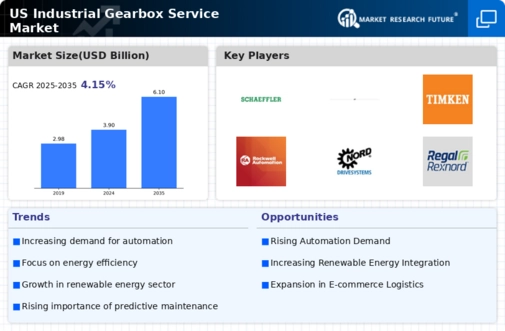Rising Demand for Automation
The industrial gearbox-service market experiences a notable surge in demand due to the increasing automation across various sectors. Industries such as manufacturing, automotive, and energy are increasingly adopting automated systems to enhance efficiency and productivity. This trend is reflected in the projected growth of the automation market, which is expected to reach approximately $200 billion by 2026. As automation systems often rely on reliable gearboxes, the need for specialized services in the industrial gearbox-service market becomes paramount. Companies are investing in advanced gearbox technologies to ensure optimal performance, thereby driving the demand for maintenance and repair services. This rising demand for automation not only enhances operational efficiency but also necessitates a robust support system, further propelling the growth of the industrial gearbox-service market.
Focus on Operational Efficiency
In the current industrial landscape, there is a pronounced focus on operational efficiency, which significantly impacts the industrial gearbox-service market. Companies are increasingly seeking ways to optimize their operations, reduce costs, and enhance productivity. This drive for efficiency often translates into the adoption of advanced gearbox technologies and regular maintenance services. The industrial gearbox-service market is likely to see growth as businesses recognize the importance of maintaining their gearboxes to prevent failures and ensure smooth operations. Furthermore, the integration of predictive maintenance technologies allows companies to anticipate gearbox issues before they escalate, thereby reducing downtime and maintenance costs. This focus on operational efficiency is expected to propel the industrial gearbox-service market forward.
Aging Infrastructure and Equipment
The industrial gearbox-service market is also driven by the aging infrastructure and equipment prevalent in various industries. Many manufacturing facilities and plants in the US operate with outdated machinery, which often requires specialized gearbox services to maintain operational efficiency. As these facilities age, the likelihood of gearbox failures increases, leading to unplanned downtimes and costly repairs. The need for refurbishment and replacement of aging gearboxes creates a substantial market opportunity for service providers. According to estimates, nearly 30% of industrial equipment in the US is over 20 years old, indicating a pressing need for gearbox maintenance and upgrades. This trend underscores the importance of the industrial gearbox-service market in ensuring the reliability and efficiency of aging industrial systems.
Expansion of Renewable Energy Sector
The industrial gearbox-service market is significantly influenced by the expansion of the renewable energy sector in the US. As the country shifts towards sustainable energy sources, the demand for wind and solar power systems has increased. Wind turbines, which rely heavily on gearboxes for energy conversion, are particularly noteworthy. The US wind energy market is projected to grow at a CAGR of around 10% through 2027, leading to a heightened need for gearbox services. This growth necessitates regular maintenance and servicing of gearboxes to ensure optimal performance and longevity. Consequently, the industrial gearbox-service market stands to benefit from this trend, as companies seek reliable service providers to maintain their renewable energy systems.
Increased Investment in Manufacturing Technologies
The industrial gearbox-service market is poised for growth due to increased investment in manufacturing technologies. As industries strive to enhance production capabilities, there is a growing emphasis on upgrading machinery and equipment, including gearboxes. The US manufacturing sector is projected to witness a growth rate of approximately 3% annually, leading to heightened demand for advanced gearbox solutions. This investment trend not only drives the need for new gearboxes but also necessitates ongoing servicing and maintenance to ensure optimal performance. Companies are likely to seek specialized services to support their advanced manufacturing processes, thereby bolstering the industrial gearbox-service market. This investment in manufacturing technologies reflects a broader commitment to innovation and efficiency within the industrial sector.




















Leave a Comment